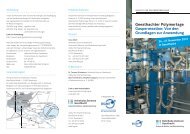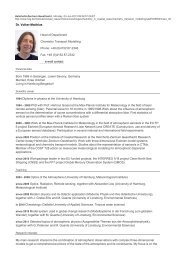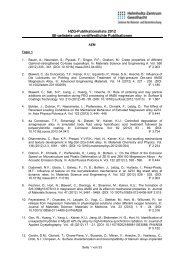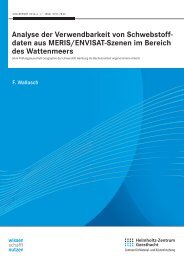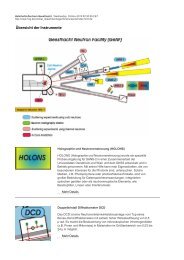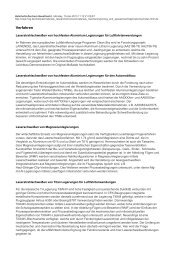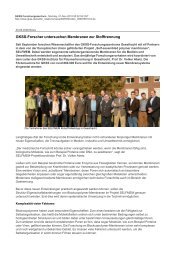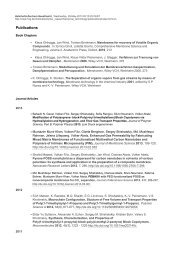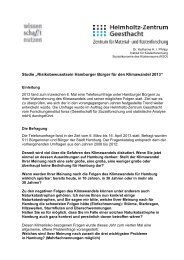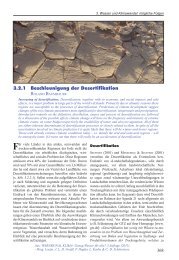Landfills and waste water treatment plants as sources of ... - GKSS
Landfills and waste water treatment plants as sources of ... - GKSS
Landfills and waste water treatment plants as sources of ... - GKSS
Create successful ePaper yourself
Turn your PDF publications into a flip-book with our unique Google optimized e-Paper software.
INTRODUCTION<br />
1.3 Physico-chemical properties<br />
Ionic <strong>and</strong> neutral PFCs, PBDEs <strong>and</strong> musk fragrances have considerably different physicochemical<br />
properties that determine their partitioning behaviour in the environment. In general,<br />
those properties are determined by their functional groups within the molecule <strong>as</strong> well <strong>as</strong><br />
carbon-fluorine chain lengths (PFCs) or bromine content (PBDEs). Physico-chemical<br />
constants <strong>of</strong> substances investigated in this study are presented in table 4.<br />
The vapour pressures <strong>of</strong> PFSAs <strong>and</strong> PFCAs are generally low (Rayne <strong>and</strong> Forest 2009). In<br />
contr<strong>as</strong>t, vapour pressures <strong>of</strong> neutral PFCs are more than 1000 times higher than those <strong>of</strong><br />
ionic PFCs (Hekster et al. 2002; Rayne <strong>and</strong> Forest 2009). Vapour pressures <strong>of</strong> PBDEs are<br />
directly linked to the bromine content <strong>of</strong> the congener. Each additional bromine substitution<br />
causes a decline <strong>of</strong> vapour pressures by factors <strong>of</strong> 6-9 (Wong et al. 2001). Musk fragrances<br />
have comparable vapour pressures <strong>as</strong> FASEs. Therefore, neutral PFCs, BDE28 <strong>and</strong> BDE47 <strong>as</strong><br />
well <strong>as</strong> musk fragrances are likely being transported <strong>as</strong> g<strong>as</strong>eous compounds in the<br />
atmosphere. Ionic PFCs <strong>and</strong> higher-brominated BDE congeners are not primarily expected in<br />
the g<strong>as</strong> ph<strong>as</strong>e, but atmospheric transport may still be possible if compounds adsorb to<br />
particles.<br />
The <strong>water</strong> solubilities <strong>of</strong> ionic PFCs are several orders <strong>of</strong> magnitude higher than those <strong>of</strong><br />
neutral PFCs. Solubility decre<strong>as</strong>es with incre<strong>as</strong>ing chain length <strong>of</strong> the both neutral <strong>and</strong> ionic<br />
PFCs (Rayne <strong>and</strong> Forest 2009). In contr<strong>as</strong>t, musk fragrances are fairly well soluble in <strong>water</strong>. It<br />
is <strong>as</strong>sumed that PBDEs are not predominantly transported via the <strong>water</strong> ph<strong>as</strong>e, where<strong>as</strong> musk<br />
fragrances are more likely entering aqueous media (Rimkus 1999; Wania <strong>and</strong> Dugani 2003).<br />
Ionic PFCs are predominantly dissolved in the aqueous ph<strong>as</strong>e <strong>and</strong>/or bound to particles<br />
(especially long-chained PFSAs) (Rayne <strong>and</strong> Forest 2009).<br />
Polycyclic musk fragrances <strong>and</strong> FTOHs have relatively high Henry’s law constants that<br />
exceed those <strong>of</strong> PBDEs <strong>and</strong> nitro musks. For PBDEs, the tendency to volatilize from the<br />
<strong>water</strong> ph<strong>as</strong>e is influenced by the degree <strong>of</strong> bromination (Wong et al. 2001). In contr<strong>as</strong>t to<br />
FTOHs, ionic PFCs have lower Henry constants (OECD 2002). Overall, it can be concluded<br />
that particularly FTOHs <strong>and</strong> polycyclic musk fragrances may volatilize from the aqueous<br />
ph<strong>as</strong>e to the atmosphere, where<strong>as</strong> PBDEs <strong>and</strong> ionic PFCs rather partition to the <strong>water</strong> ph<strong>as</strong>es.<br />
It h<strong>as</strong> been reported that KOA values for PBDEs, FTOHs, FASAs <strong>and</strong> FASEs are incre<strong>as</strong>ing<br />
with decre<strong>as</strong>ing <strong>of</strong> temperatures (Harner <strong>and</strong> Shoeib 2002; Thuens et al. 2008; Dreyer et al.<br />
2009a). Particularly highly brominated congeners are expected in the particle ph<strong>as</strong>e (Harner<br />
<strong>and</strong> Shoeib 2002). For musk fragrances KOA values have not yet been reported. However,<br />
10



